Choosing the best motherboard for gaming is one of the most important steps in building or upgrading your PC. While the GPU and CPU often get most of the attention, the motherboard acts as the backbone of your system connecting all components, determining compatibility, and even impacting performance, stability, and future upgradability.
In this comprehensive guide, we’ll explore the top-rated gaming motherboards in 2025, what features matter most, and how to choose the best board for your gaming needs, whether you’re a casual gamer or a professional streamer.
A motherboard may not directly increase your frame rate, but it plays a huge role in how well your system performs, especially when it comes to:
- Power delivery and overclocking
- Component compatibility (RAM, CPU, GPU, SSDs)
- Connectivity options (USB ports, Wi-Fi, Ethernet, audio)
- Cooling support and thermal design
- Expansion possibilities
- Aesthetic appeal with RGB and sleek designs
With features like PCIe 5.0, DDR5 memory, Wi-Fi 6/6E/7, and USB 4.0 becoming standard in 2025, choosing the right motherboard means setting yourself up for current and future gaming success.
When building a high-performance gaming PC, choosing the best motherboard for gaming is crucial. It acts as the central hub that connects all your components—CPU, GPU, RAM, storage, and cooling systems. A quality gaming motherboard ensures system stability, maximizes hardware compatibility, and supports cutting-edge features like PCIe 5.0, DDR5 memory, and Wi-Fi 6E or 7.
Whether you’re going for an Intel or AMD build, investing in the right motherboard can significantly impact your gaming experience—delivering faster load times, better frame rates, and smoother multitasking. In this guide, we’ll explore the top gaming motherboards in 2025, tailored for every budget and build type.
Here’s a detailed breakdown of the key features you should evaluate before choosing the best gaming motherboard:
Motherboards are brand-specific to either Intel or AMD processors. You’ll need:
- LGA 1700 socket for Intel’s 12th, 13th, or 14th Gen CPUs.
- AM5 socket for AMD Ryzen 7000 and newer.
Check the chipset (e.g., Z790, B760 for Intel; X670, B650 for AMD) for advanced features like overclocking or multi-GPU support.
- ATX – Standard size, offers most expansion and features.
- Micro-ATX – Smaller, fewer slots but budget-friendly.
- Mini-ITX – Compact, ideal for small form factor (SFF) builds.
In 2025, DDR5 RAM is the new standard, offering faster data rates and efficiency. Some motherboards still support DDR4, but for future-proofing, go with DDR5.
- PCIe 5.0 x16 for next-gen GPUs
- M.2 NVMe slots for SSDs (up to 4 or more on high-end boards)
- SATA ports for HDDs and older SSDs
- USB 3.2 Gen 2×2 / USB4
- Wi-Fi 6E or Wi-Fi 7 for wireless
- Bluetooth 5.3
- 2.5G/10G Ethernet
- HD Audio codecs (ALC1220 or higher for gamers)

Below are the top-rated gaming motherboards across different categories—Intel, AMD, high-end, budget, and compact builds.
Best Premium Intel Motherboard for Gaming
- Socket: LGA 1700
- Chipset: Z790
- Form Factor: ATX
- RAM: DDR5, up to 7800MHz
- Networking: Wi-Fi 7, 2.5Gb LAN, Bluetooth 5.3
- Expansion: PCIe 5.0 x16, 4x M.2 slots
Why it’s great:
This is a feature-packed board designed for overclockers and serious gamers. It includes AI Overclocking, AI Cooling II, and enhanced VRM design. The onboard RGB, premium heatsinks, and reinforced slots make it visually stunning too.
Best AMD Motherboard for Mid-Range Gaming
- Socket: AM5
- Chipset: B650
- Form Factor: ATX
- RAM: DDR5 up to 6400+ MHz
- Networking: Wi-Fi 6E, 2.5G LAN
- Storage: 3x M.2, 6x SATA
Why it’s great:
A perfect blend of performance and affordability. It supports the powerful Ryzen 7000 series CPUs and has robust VRMs for moderate overclocking. It’s ideal for 1080p and 1440p gamers who want solid performance on a budget.
Best High-End AMD Motherboard for Enthusiasts
- Socket: AM5
- Chipset: X670E
- Form Factor: ATX
- RAM: DDR5 up to 8000 MHz
- Connectivity: USB 4.0, Wi-Fi 6E, Bluetooth 5.2
- Expansion: PCIe 5.0 GPU + SSD support
Why it’s great:
If you want no compromise, this is your board. With PCIe 5.0 on GPU and SSDs, a 16+2+2 phase power delivery, and top-tier cooling, it’s ideal for 4K gaming, streaming, and content creation.
Best Budget Intel Gaming Motherboard
- Socket: LGA 1700
- Chipset: B760
- Form Factor: Micro-ATX
- RAM: DDR5 up to 7200 MHz
- Storage: 2x M.2, 4x SATA
- Features: Wi-Fi 6E, RGB, 2.5G LAN
Why it’s great:
This board proves that budget doesn’t mean boring. It supports 14th Gen Intel chips and high-speed DDR5 memory. A great choice for entry-level to mid-range gaming builds.
Best Mini-ITX Motherboard for Compact Gaming PCs
- Socket: AM5
- Chipset: B650
- Form Factor: Mini-ITX
- RAM: DDR5
- Networking: Wi-Fi 6E, Bluetooth 5.3
- Storage: 2x M.2, 2x SATA
Why it’s great:
Ideal for small form factor gaming PCs, this board doesn’t skimp on features. It includes high-speed networking, strong audio output, and supports powerful CPUs like the Ryzen 7 7800X3D.
- Avoid outdated chipsets. In 2025, go for Z790, B760 (Intel), or X670, B650 (AMD).
- Don’t overspend on features you won’t use (e.g., multiple PCIe slots if you’re not using multi-GPU).
- Check BIOS updates for new CPU support, especially on budget boards.
- Future-proof with DDR5, PCIe 5.0, and Wi-Fi 6E/7 if your budget allows.
- Read customer reviews and trusted benchmarks before buying.
Some Intel B760 and Z790 boards support DDR4, but AMD AM5 only supports DDR5.
PCIe 5.0 SSDs and GPUs are just starting to roll out. It’s a great future-proof feature but not essential for everyone today.
If you’re using a wireless connection, yes. Otherwise, you can save money with a non-Wi-Fi board and use Ethernet.
With proper care, a high-quality motherboard can last 5–7 years, depending on how often you upgrade your CPU and GPU.
The best motherboard for gaming depends on your needs:
- High-end Intel build? Go with ASUS Z790-E.
- Mid-range AMD setup? The MSI B650 Tomahawk offers superb value.
- Small form factor build? Choose the ROG B650-I.
- On a budget? Try ASRock B760M Steel Legend.
No matter your budget, there’s a gaming motherboard that will maximize your system’s performance and keep you competitive in today’s demanding gaming landscape.
B650 Motherboard: The Perfect Balance of Performance and Value
AM5 Motherboard: The Ultimate Guide for Gamers, Creators & PC Builders (2025)
How Do Motherboards Work? | Tech Quickie
